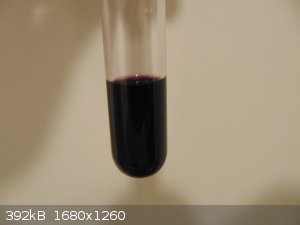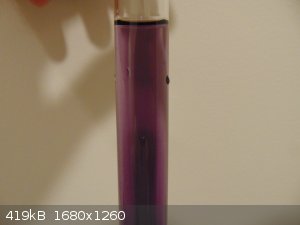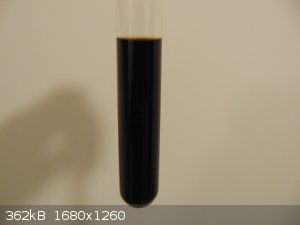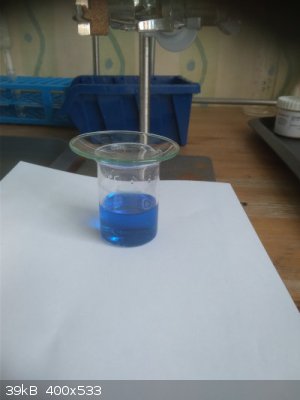teodor
National Hazard
   
Posts: 872
Registered: 28-6-2019
Location: Heerenveen
Member Is Offline
|
|
Inorganic compounds with most intense colour in water solution
I try to record a level of water vs time with help of computer camera in gas experiments. I'd like to stain it to make the level easily visible on
photos. I'd like to use as little grams of compound per litter of water as possible, also I need several options because some of compounds could
react with some gases I generate.
Thus, I'd like to create a table of most intense coloured compounds, preferable inorganic because I think it will take less time to make them compared
to organic water soluble dyes and also the reaction with various gases (colour changes) could be more predictable, at least for me.
So, I want to create the list of most coloured (inorganic) compounds. I can put KMnO4 as the line 1 but I will never use it because it stains glass
and I plan to wash my glassware only once per week or even less. So, I think I will try first some Co salts/complexes.
So, what else can I use?
|
|
|
Tsjerk
International Hazard
    
Posts: 3022
Registered: 20-4-2005
Location: Netherlands
Member Is Offline
Mood: Mood
|
|
I could send you some [Fe(bpy)3]Br2. This compound is very soluble and very red/pink. I didn't do any dilution series but my
guess is it is pink in the ppm range. Higher concentrated solutions are dark red and the solid is almost black.
Also the Fe(II) is very stable in this complex. Oxygen doesn't oxidize it, so slightly oxidizing conditions should not be a problem. According to
literature the resulting Fe(III) complex would be blue.
Edit: I just dissolved a couple milligrams in 200 ml of water, the solution is quite red already. I estimate 0.1 ppm is pink, 1 ppm is starting to
become red and 10 ppm is red.
[Edited on 5-5-2020 by Tsjerk]
|
|
|
Bedlasky
International Hazard
    
Posts: 1219
Registered: 15-4-2019
Location: Period 5, group 6
Member Is Offline
Mood: Volatile
|
|
Fe(III), Co(II), Mo(V) isothiocyanate complexes - very intense red, blue, red colours.
Mo and W blue - dark blue colour, but they slowly form precipitate
Fe(III)-salicylate complex - dark purple colour
V(IV) and Cu(I)/Cu(II) heteropolymolybdates - dark purple and brown colour (they can be prepared by mixing VO2+ ions or Chevreul's salt with ammonium
heptamolybdate)
Mo(III)-aqua complexes - very dark green, sensitive to air
[Ti(H2O)Cl5]2- - very dark blue, sensitive to air, exists only in conc. HCl
[Edited on 5-5-2020 by Bedlasky]
|
|
|
Boffis
International Hazard
    
Posts: 1836
Registered: 1-5-2011
Member Is Offline
Mood: No Mood
|
|
Could it be organic, like gentian violet (methyl violet)?
|
|
|
teodor
National Hazard
   
Posts: 872
Registered: 28-6-2019
Location: Heerenveen
Member Is Offline
|
|
Yes it could. I checked possible routes yesterday for AZO dyes & Congo Red. Also I have methyl orange, methyl red as well as some dyes for use in
microscopy on my shelf. I don't have benzene, so it makes many routes for some dyes more complex (but well, I have 1-naphthol). Generally I would
exclude yellow or orange dyes from my list, blue or intense red is much better for my purpose.
And for this particular purpose Gentian violet is not the dye of choice, because in my experiments the gas mixture almost always contains small amount
of chlorine which can bleach it. And I think I will have the same problem with many organic compounds.
But colorimetric detection of chlorine is also part of my experiments, so possible I will use some organic dyes also but more to detect chlorine
presence.
|
|
|
teodor
National Hazard
   
Posts: 872
Registered: 28-6-2019
Location: Heerenveen
Member Is Offline
|
|
Quote: Originally posted by Bedlasky  |
V(IV) and Cu(I)/Cu(II) heteropolymolybdates - dark purple and brown colour (they can be prepared by mixing VO2+ ions or Chevreul's salt with ammonium
heptamolybdate)
[Edited on 5-5-2020 by Bedlasky] |
I would try it.
I try to avoid thiocyanate as well as cyanate ligands because I afraid to create cyanogen chloride somehow in case of my Cl2 scrubber fails.
Air sensitivity is good for other experiments but not for this one, thank you for the information.
I try to avoid any precipitation, the system should be usable for long run.
Did you mention some other Co/Fe/Ni complexes?
[Edited on 5-5-2020 by teodor]
|
|
|
Bedlasky
International Hazard
    
Posts: 1219
Registered: 15-4-2019
Location: Period 5, group 6
Member Is Offline
Mood: Volatile
|
|
There are plenty of these complexes with strong coloration.
[Ni(NH3)6]2+ and [Ni(edta)]2- have strong blue colour.
[Co(NH3)6]3+ have dark brown colour.
Cu(II) forms many dark blue complexes - with ammonia, citrate and polyhydroxy compounds. About last mentioned I plan write some article. I did few
experiments with it and some of these complexes are pretty stable. Most stable are complexes with tartrate, glycerol and sorbitol. They only very very
very slowly decomposes in to Cu2O. But the amount of Cu2O is very very small, so you don't have to worry about precipitation. On the other hand
complexes with glucose, fructose etc. are quite unstable.
Ni(II) and ethylenediamine forms light blue, dark blue and purple complexes depending on Ni:en ratio.
Quote: Originally posted by teodor  | Quote: Originally posted by Bedlasky  |
V(IV) and Cu(I)/Cu(II) heteropolymolybdates - dark purple and brown colour (they can be prepared by mixing VO2+ ions or Chevreul's salt with ammonium
heptamolybdate)
[Edited on 5-5-2020 by Bedlasky] |
I would try it.
[Edited on 5-5-2020 by teodor] |
Just dissolve vanadium pentoxide in NaOH to make cca 1,5% Na3VO4 solution (which is colourless). Than acidified it to pH around 4-5. Dissolve excess
of ammonium heptamolybdate in approximately the same volume of water, mix both solutions and dilute it as you need. Here are two photos of it. As you
see, complex have very intense colour.
 
Mixed valence Cu complex is even simplier to preparation. Dissolve some Cu(II) salt in water (make cca 1% solution) and reduce it with excess of
sodium metabisulfite. Dissolve again ammonium heptamolybdate in the same volume of water and mix both liquids. Than dilute as you need. Again I'm
attaching a photo.

Metal heteropolymolybdates have generally low solubility and can be easily precipitate from solution. But if concentration is low enough there
shouldn't be any solid. With these two complexes I worked only in test tube, V(IV) complex never precipitated out (I use 1,5% Na3VO4 as starting
solution), Cu(I)/Cu(II) complex precipitates out from 2,5% CuSO4.5H2O solution, but as I said, if solution is dilute enough, there is no precipitate.
Keep pH of solutions at 3-4, in neutral solution often precipitates out molybdates (so dilute it with some weakly acidic water).
Quote: Originally posted by teodor  | | But colorimetric detection of chlorine is also part of my experiments, so possible I will use some organic dyes also but more to detect chlorine
presence. |
For spectrophotometric determination are used o-tolidine (measuring at 435nm) and N,N-diethyl-1,4-phenylenediamine (measuring at 510nm).
[Edited on 5-5-2020 by Bedlasky]
|
|
|
Heptylene
Hazard to Others
  
Posts: 319
Registered: 22-10-2016
Member Is Offline
Mood: No Mood
|
|
Potassium triiodide? I.e. iodine in KI solution.
|
|
|
teodor
National Hazard
   
Posts: 872
Registered: 28-6-2019
Location: Heerenveen
Member Is Offline
|
|
Quote: Originally posted by Bedlasky  |
Just dissolve vanadium pentoxide in NaOH to make cca 1,5% Na3VO4 solution (which is colourless). Than acidified it to pH around 4-5. Dissolve excess
of ammonium heptamolybdate in approximately the same volume of water, mix both solutions and dilute it as you need. |
Because I have no ammonium heptamolybdate on hand I gave a try to prepare it by dissolving my MoO3 (from a pottery shop) in ~7 times excess of 25%
NH3. I've got a blue filtrate after this reaction:

and a lot of brown/white precipitation (possible Fe).
I believe I can get ammonium heptamolybdate from it by evaporation at room temperature but possible I can try to use this solution directly, I only
doubt I can reduce pH without breaking heptamolybdate. But I can try different ways, I don't need a pure compound, just some dye.
|
|
|
teodor
National Hazard
   
Posts: 872
Registered: 28-6-2019
Location: Heerenveen
Member Is Offline
|
|
It is a good idea but I doubt it will corrode my equipment (this solution should have contact with outer atmosphere -like in a barometer).
[Edited on 5-5-2020 by teodor]
|
|
|
Sulaiman
International Hazard
    
Posts: 3555
Registered: 8-2-2015
Location: 3rd rock from the sun
Member Is Offline
|
|
methyl violet bleaches in an oxidising environment but
methylene blue is blue in an oxidising environment, colourless in a reducing environment.
CAUTION : Hobby Chemist, not Professional or even Amateur
|
|
|
Bedlasky
International Hazard
    
Posts: 1219
Registered: 15-4-2019
Location: Period 5, group 6
Member Is Offline
Mood: Volatile
|
|
Quote: Originally posted by teodor  |
Because I have no ammonium heptamolybdate on hand I gave a try to prepare it by dissolving my MoO3 (from a pottery shop) in ~7 times excess of 25%
NH3. I've got a blue filtrate after this reaction:
and a lot of brown/white precipitation (possible Fe).
I believe I can get ammonium heptamolybdate from it by evaporation at room temperature but possible I can try to use this solution directly, I only
doubt I can reduce pH without breaking heptamolybdate. But I can try different ways, I don't need a pure compound, just some dye.
|
This is really weird. Blue colour is in my opinion caused by molybdenum blue. Make solution acidic and add little bit of nitrate - blue colour should
disappear. But don't add too much, because you will need reduce vanadium in to IV oxidation state. Try oxidation by nitrate first in test tube scale.
When you dissolve MoO3 in NH3 you obtain ammonium molybdate, not heptamolybdate. Heptamolybdates are formed at pH 3-6. Below pH 3, octamolybdates are
formed. I mentioned ammonium heptamolybdate because it forms acidic solutions. But it's irelevant which source of heptamolybdate ions you choose. You
can also use MoO3, sodium molybdate, ammonium molybdate... There is important pH of solution - in weakly acidic solution metal heteropolymolybdates
are formed, while in neutral solution much less soluble metal molybdates are formed. I now write article about molybdenum complexes but it isn't
finish yet - I mention formation of these complexes in this article.
|
|
|
nezza
Hazard to Others
  
Posts: 324
Registered: 17-4-2011
Location: UK
Member Is Offline
Mood: phosphorescent
|
|
Fluorescein is often used as a tracer in water. It is intensely coloured and fluorescent at very low concentrations and is easy to make.
If you're not part of the solution, you're part of the precipitate.
|
|
|
teodor
National Hazard
   
Posts: 872
Registered: 28-6-2019
Location: Heerenveen
Member Is Offline
|
|
Quote: Originally posted by Sulaiman  | methyl violet bleaches in an oxidising environment but
methylene blue is blue in an oxidising environment, colourless in a reducing environment.
|
Thank you, I will add both to my list. I didn't know that about methylene blue.
Quote: Originally posted by Bedlasky  | For spectrophotometric determination are used o-tolidine (measuring at 435nm) and N,N-diethyl-1,4-phenylenediamine (measuring at 510nm).
|
I need both of them. I checked the price of o-Tolidine and it is insane - smth. around 300 EUR per 50g, so I have a plan to synthesise it. And I have
Is N,N-diethyl-1,4-phenylenediamine in the form of "DPD 1" tablets for a pool. I think I can extract it in a pure form for the purpose of
quantitative/volumetric analysis.
I think it doesn't. By concentrating solution (evaporation at room temperature) I get a clear crystals very similar in appearance to CuSO4 hydrate. I
have a plan to purify my MoO3 by dissolving in NaOH, filtering, neturalization, acidification to get MoO3 * nH2O again, reaction with NH3 and partial
acidification with HCl to get a "hepta-" form. Of course I can buy it but today delivery time can take much longer then just making it.
Quote: Originally posted by nezza  | | Fluorescein is often used as a tracer in water. It is intensely coloured and fluorescent at very low concentrations and is easy to make.
|
It is a very good idea, and also I already have it in my list because it could be somehow used also as Cl2 indicator.
|
|
|
Bedlasky
International Hazard
    
Posts: 1219
Registered: 15-4-2019
Location: Period 5, group 6
Member Is Offline
Mood: Volatile
|
|
Quote: Originally posted by teodor  |
I think it doesn't. By concentrating solution (evaporation at room temperature) I get a clear crystals very similar in appearance to CuSO4 hydrate. I
have a plan to purify my MoO3 by dissolving in NaOH, filtering, neturalization, acidification to get MoO3 * nH2O again, reaction with NH3 and partial
acidification with HCl to get a "hepta-" form. Of course I can buy it but today delivery time can take much longer then just making it.
|
But ammonium molybdate is white solid. I know only these blue molybdenum compounds: Molybdenum blues, molybdenum bronzes and nickel(II) or copper(II)
heteropolymolybdates.
|
|
|
Bezaleel
Hazard to Others
  
Posts: 444
Registered: 28-2-2009
Member Is Offline
Mood: transitional
|
|
Quote: Originally posted by teodor  |
I think it doesn't. By concentrating solution (evaporation at room temperature) I get a clear crystals very similar in appearance to CuSO4 hydrate. I
have a plan to purify my MoO3 by dissolving in NaOH, filtering, neturalization, acidification to get MoO3 * nH2O again, reaction with NH3 and partial
acidification with HCl to get a "hepta-" form. Of course I can buy it but today delivery time can take much longer then just making it.
|
That's the way I think. You could also use ammonia solution to precipitate d-block impurities from your MoO3. Let it stand for half an hour to be sure
the maximum amount of d-block hydroxides have formed, and filter.
Ammonium heptamolybdate forms colourles crystals on evaporation. None of the d-block polymolybdates are stable in alkaline solution.
If you want to precipitate out MoO3 from your (hepta)molybdate, I suggest to think well about the acid you use. HCl is able to solve large amounts of
MoO3, forming all sorts of Mo-oxychlorides, which do not fully decompose on calcination.
HNO3 forms several sorts of hydrated MoO3 species, one of which is yellow-orange in colour. They often still contain HNO3. Basic Mo-sulphates are
known, and may form from MoO3 in dilute H2SO4 (according to Mellor).
|
|
|